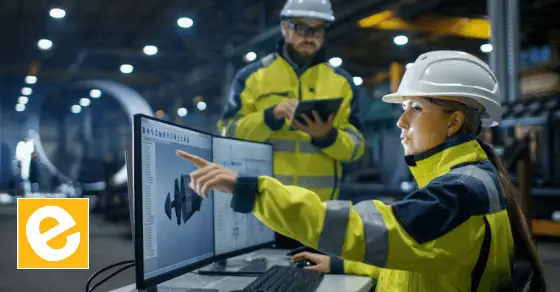The industry of construction has historically not been quick to embrace the latest technologies, relying mostly on traditional techniques. This has been changing fast as the latest technology is changing the way that structures are constructed, designed, and maintained. From BIM (building information modeling) (BIM) and drones to artificial intelligence (AI) technology, innovations are improving safety, efficiency, and sustainability throughout the construction industry. In this article, we’ll look at how technology is transforming the industry of construction today.
Emerging Technologies Driving Change
Building Information Modeling (BIM)
One of the major technological advancements in the field of construction involves Building Information Modeling (BIM). BIM is a 3D model-based procedure that permits engineers, architects, and contractors like the Interior Design Company in Oman to work effectively. energetically. Through the creation of an electronic model of a building’s practical and physical characteristics, BIM helps reduce errors and inconsistencies throughout the process of construction.
BIM is not just a way to improve the accuracy of design, but it also permits to testing of virtual possibilities before the construction process begins. The ability to predict outcomes in fewer design mistakes, eventually saving time and energy. Furthermore, BIM promotes sustainability by making the most of material use, eliminating consumption, and enhancing energy efficiency. This means that building projects with BIM can not just be better-performing, but they are also green.
Drones and Aerial Surveying
Drones are now a game changer in the construction industry. With high-resolution cameras as well as sensors, drones can survey massive construction sites quickly and effectively. These drones add real-time reports on conditions at the site as well as progress monitoring and inspections that normally are time-consuming and take weeks together with traditional methods.
Apart from speeding processes drones also raise security in construction locations. They can access dangerous and difficult-to-reach places, thus reducing the necessity for human laborers to work in hazardous circumstances. In addition to collecting information from very difficult perspectives, drones are also able to provide precise site assessment which reduces the chance of making mistakes, and also ensuring that project progress is on the right track.
3D Printing in Construction
Another new technology making waves in the construction industry is 3D printing. Although traditionally used for manufacturing, 3D printing is being utilized to produce construction parts and entire structures. The technology can add significant costs and time savings by making it easier to create intricate building components with less production waste.
Alongside efficiency, 3D printing also allows more design freedom. Architectural designers can explore innovative complex designs that might have been difficult or impossible to construct together with conventional techniques. Utilizing 3D printing has particular promise as a solution to affordable housing in which speed and affordability are vital.
Robotics and Automation
Robots and automation are employed to tackle the shortage of labor and boost efficiency in the construction industry. Robots can perform the repetitive tasks of bricklaying, demolition, or material handling with accuracy and uniformity. This decreases the possibility of human errors and increases the speed of construction.
Automating labor-intensive or risky work, robots improve worker safety as well as allow workers to concentrate on more challenging tasks. As construction sites get more automated, the construction industry is expected to see increased efficiency and shorter project times.
The Role of AI and Machine Learning
AI for Predictive Analytics
Artificial Intelligence (AI) has been making an impact on construction in particular by using predictive analytics. Through the analysis of huge amounts of past project data, AI can benefit project management by predicting the outcome, recognizing possible risks, and making more informed choices. The analysis of data in real time allows the construction team to spot difficulties before they arise and can result in fewer delays and fewer cost overruns particularly when working with products such as high-Quality Galvanized Sheet which require careful surveillance to warrant optimal use.
AI can also be used in the field of predictive maintenance. Monitoring the efficiency of equipment, AI algorithms can identify which machinery is most likely to malfunction and then schedule maintenance in advance of when breakdowns happen. This minimizes downtime and ensures that construction sites stay efficient.
Machine Learning for Design and Planning
Machine learning, which is a subset of AI can transform the planning and design phases of construction. Through the analysis of past project information machine learning algorithms can enhance designs to improve effectiveness, cost, and environmental sustainability. This assists architects and engineers in determining the accurate techniques and construction of the right materials for any given project, while also increasing the overall outcomes of projects.
Additionally, the machine learning process can help in the allocation of resources by anticipating how to make the best utilization of materials and labor. This results in more precise schedules and budgets for projects which reduces the chance of expensive delays.
Sustainability and Green Construction
Sustainability has been a major concern within the construction industry and technology plays an important role in the development of eco-friendly building methods. The latest technologies allow construction companies to minimize their impact on the environment by optimizing the use of energy while reducing waste as well as making use of eco-friendly materials.
In particular Smart building systems permit the monitoring of the consumption of energy during and after the construction. They can spot energy inefficiencies in cooling, heating as well as lighting, allowing the building owner to cut down on the usage of energy as well as reduce operating costs. In addition, the use of recycled materials and modular construction methods–supported by technologies like BIM and 3D printing–contributes to more sustainable building practices.
Improving Safety and Reducing Risks
Wearable Technology and IoT
The security of the workers is a major goal on every construction site. Wearable technology has been assisting in enhancing safety measures. Smart vests, helmets, and glasses with sensors can monitor workers’ essential signs, keep track of their movements, and identify possible hazards in real time. The wearables often integrate into Internet of Things (IoT) gadgets, which can identify hazards in the environment, like structural flaws and gas leaks as well as the possibility of fire.
IoT sensors are integrated into buildings and other equipment to check the condition of buildings and machines. This systematic approach to managing risk helps construction firms stop accidents from happening and create a safer working place for everyone.
Virtual and Augmented Reality (VR/AR)
Virtual and virtual reality (VR/AR) are now becoming essential instruments in the construction sector. VR lets construction workers be immersed in a virtual setting, in which they can perform tasks and troubleshoot possible issues while not on the job site. This can be particularly beneficial to train in because employees can become familiar with complicated procedures within a safe space.
AR On its own, can enhance reality-based views by overlaying digital images on physical objects. As an example, architects and engineers could utilize AR to see plans of construction directly on construction sites which makes it much easier to evaluate the plan against the actual building. This helps increase accuracy and minimize the chance of costly errors when building.
Challenges and Barriers to Adoption
Despite the positives that construction has, it faces numerous challenges in adopting modern technology. The high upfront cost and the resisting change are the most common challenges, particularly for businesses with limited funds and those who rely on ff&e procurement services for the purchase of needed tools and equipment. Also, there is a huge knowledge deficit, given that most construction workers require instruction in the use of digital technology and tools.
In addition, regulatory and legal issues must be dealt with when new technologies are introduced. Concerns like data privacy and safety requirements for robots and the liability issues associated with AI-driven decisions must be addressed to assure widespread acceptance.
Conclusion
Technology is undoubtedly changing the field of construction and bringing more efficiency, security, and environmental sustainability. From drones and BIM, through AI as well as robotics the technologies present today are changing the way construction projects are planned as well as managed and completed. Although there are still challenges, businesses that embrace the latest technologies will have a better chance to prosper in an ever-aggressive market. Construction’s future is now here and made possible by technological advances.




